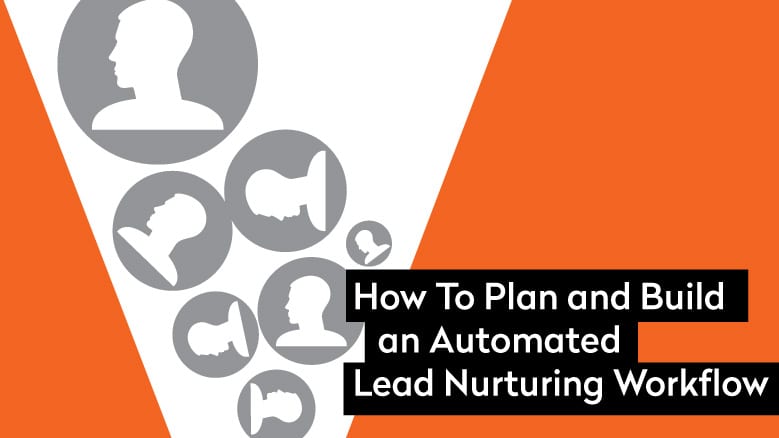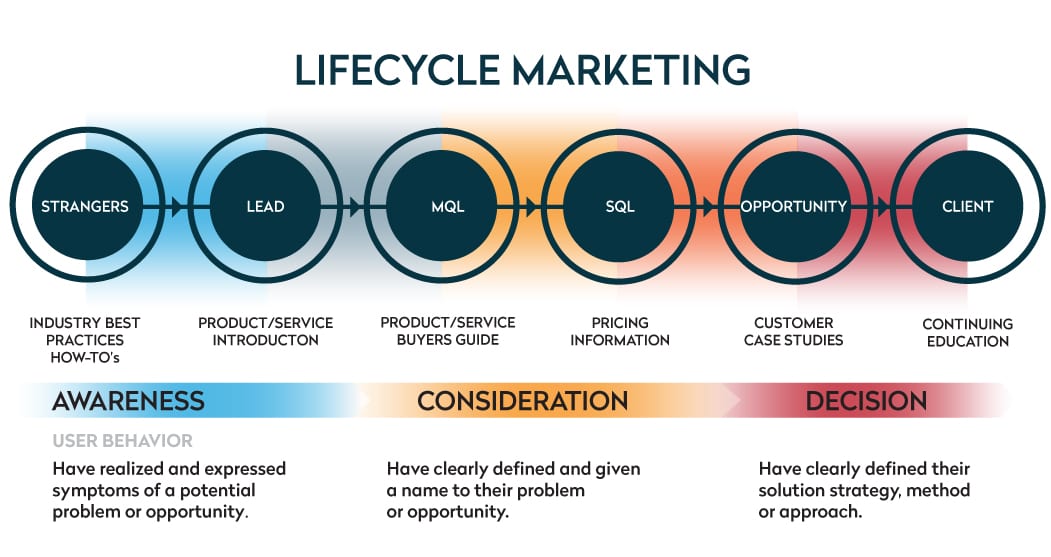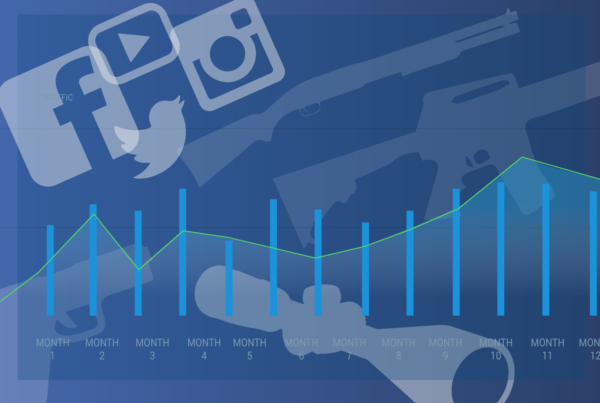
Your campaign doesn’t end when leads convert on your landing page. Understanding your buyer’s journey from Awareness to Consideration to Decision is critically important in setting up lead nurturing workflows.
What is a workflow?
Workflows give you the ability to automate your marketing to actual people, not just clicks and opens. A workflow tool is included in most marketing automation platforms like HubSpot.
What is lead nurturing?
Lead nurturing is a workflow of engaging contacts via automated touches (email) to build a relationship; with the end goal of closing a more educated and qualified customer. When engaging in lead nurturing, you need to be aware of three principles that will make them effective.
Each workflow should address the following:
Grow and nurture relationships – Ask yourself, is this adding value to the contact or is it self-serving?
Educational content – Does this content help or educate your contact?
Hyper-personalization – Try to personalize your workflows as much as possible. This is also called segmentation. As an example, don’t send emails meant for C-Suite executives to mid-level managers. Create and tailor content based on your buyer persona.
Lead nurturing is especially effective for businesses that offer complex products and services. Lead nurturing helps educate your prospect by spoon feeding them information in a way that educates them slowly that doesn’t overwhelm them; with the end goal of moving them from awareness to decision.
Here are some facts as to why lead nurturing is important:
- 79% of marketing leads never convert into sales. Lack of lead nurturing is the common cause of this poor performance. (Source: MarketingSherpa)
- Only 25% of leads are legitimate and should advance to sales. (Source: Gleanster Research)
- Research shows that 35-50% of sales go to the vendor that responds first. (Source: InsideSales.com)
- 61% of B2B marketers send all leads directly to Sales; however, only 27% of those leads will be qualified. (Source: MarketingSherpa)
- Nurtured leads make 47% larger purchases than non-nurtured leads. (Source: The Annuitas Group)
- Companies that excel at lead nurturing generate 50% more sales ready leads at 33% lower cost. (Source: Forrester Research)
- A whopping 68% of B2B organizations have not identified their funnel. (Source: MarketingSherpa)
- Today, customers manage 85% of their relationship without talking to a human. (Source: Gartner Research)
In this post, I give you 5 best practices for automating your lead nurturing workflows.
1. Identify the goal of the workflow
The most popular goal of any workflow is based around the marketing lifecycle. Your focus will be on moving your contact to the next stage of the lifecycle.
So for example, a workflow goal would look something like this:
- Goal = Download Whitepaper
- Goal = Contact attends webinar
- Goal= Visits x number pages on your website
- Goal= Contact request demo
- Goal= Contact signs contract
 To the right is a sample workflow that overlays the sales funnel and buyers lifecycle with the inbound marketing methodology. We will discuss the types of email to send once the contact opts in to the sales funnel shortly. The goal of this workflow is to move them through your workflow in an effort to build trust—so that they achieve your end goal. In this example the end-goal is: request a demo.
To the right is a sample workflow that overlays the sales funnel and buyers lifecycle with the inbound marketing methodology. We will discuss the types of email to send once the contact opts in to the sales funnel shortly. The goal of this workflow is to move them through your workflow in an effort to build trust—so that they achieve your end goal. In this example the end-goal is: request a demo.
2. Identify contacts that should be enrolled in your workflow
When designing your workflows, make sure to enroll the correct personas. This can be done through your landing page forms by requiring your visitor to self-identify. See Landing Page Best Practices.
3. Select the appropriate number and type of emails to send
To identify the appropriate number of emails you should send, breakdown the types of email into 4 classes:
1. Email 1: Goal = Build trust/condition
The purpose of this type of email is to build trust and relevancy. Make sure whatever you send, it’s something your contact will find useful. The email should also reference why you’re reaching out to them and provide some useful blog links (this is a great way to drive additional traffic to your website). When executed correctly, you’ll begin to build trust that will help condition them to open future emails. Keep your emails short and simple, make sure the subject line is relevant to the action the contact took, always include a link back to the page they signed up on and personalize it. Delay 4 days from first touch.
2. Email 2: Goal = Additional downloads
Once you’ve establish some level of trust, you want to begin to draw a connection between the topic of your workflow and your solution. This could be in the form of whitepapers, ebooks, webinars or case studies. You allow them to consume your resources to further understand your organizations value. At this stage you are not yet selling them. You are still building trust. Delay 4 days from second touch.
3. Email 3 & 4: Goal = Soft/Hard Goal
By now, your contacts that are engaged will trust you and are beginning to understand the value of your organization and how you will solve their problem. You’ve probably seen them on your website a few more times—these are signals of a qualified lead. Now is the time to position your goal of the workflow (request a demo) as the next logical step for the contact to take. Position this step as part of the discovery process by focusing on delivering more detail on how you can specifically help them. At this point, they should be interested in talking to you and signing up for a demo. Delay 3 days from third touch.
4. Email 5: Goal = Breakup/Goal Action
The break-up email is designed to make it clear that this is the last email they will be receiving in conjunction with the type of emails they’ve been getting. Our goal with this email is to make one last-ditch effort to complete your goal (request a demo). Let them know this is the last email, and ask them to subscribe to your blog. Believe it or not, a P.S. works well here. Delay 3 days from fourth touch.
4. A word on timing
Timing is always important when nurturing your leads. You can easily upset people by emailing them too much or too little. There is a delicate balance when playing with the timing of your emails. Experiment with what times work best. Do not email your contact every day otherwise you’ll get flagged for spam. A safe place to start is one email every week for 4 weeks.
5. Identify contacts to suppress from your workflow
When setting up your lead nurturing workflows make sure to exclude any current customers, opportunities, competitors or contacts were a specific product or service is not relevant.
What if a contact just bypasses the whole workflow and calls me? Sometimes, a contact will just call you after spending some time on your website and bypass the entire workflow. Continue to follow the workflow and be prepared to tweak it slightly. The goal is still to educate them and distinguish your services from potential competitors they may be evaluating.
In conclusion, the lead nurturing process always starts with a desired end goal. Each email should be educational, simple and short, personalized and timed correctly. Each stage of the buyer’s lifecycle should be kept in mind as you move your contact to the next stage. By conducting lead nurturing you can expect to send your sales team more “sales-qualified” leads and close more business.






